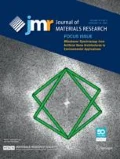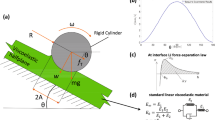Abstract
The numerical approach of Lee et al. [Trans. Korean Soc. Mech. Eng., A28, 816–825 (2004)] to spherical indentation technique for property evaluation of hyperelastic rubber is enhanced. The Yeoh model is adopted as the constitutive form of rubber material because it can express well large deformation and cover various deformation modes with a simple form. We first determine the friction coefficient between a rubber specimen and a spherical indenter in a practical viewpoint and perform finite element simulations for a deeper indentation depth than that selected by Lee et al. [Trans. Korean Soc. Mech. Eng., A 28, 816–825 (2004)]. An optimal data acquisition spot is selected, which features sufficiently large strain energy density and negligible frictional effect. We improve then two normalized functions mapping an indentation load–displacement curve onto a strain energy density–invariant curve, the latter of which gives the Yeoh model constants. The enhanced spherical indentation approach successfully produces the rubber material properties with an average error of less than 5%. The validity of our developed approach is verified by experimental evaluation of material properties with three kinds of rubber materials.





















Similar content being viewed by others
References
W.D. Kim, D.J. Kim, W.S. Kim, and Y.S. Lee: A study on the equi-biaxial tension test of rubber material. Trans. KSAE 11, 95–104 (2003).
H. Lee, D.W. Kim, J.H. Lee, and S.H. Nahm: Software and hardware development of micro-indenter for material property evaluation of hyper-elastic rubber. Trans. Korean Soc. Mech. Eng. A 28, 816–825 (2004).
O.H. Yeoh: Characterization of elastic properties of carbon-black-filled rubber vulcanizates. Rubber Chem. Technol. 63, 792–805 (1990).
O.H. Yeoh: Some forms of the strain energy function for rubber. Rubber Chem. Technol. 66, 754–771 (1993).
O.H. Yeoh and P.D. Fleming: A new attempt to reconcile the statistical and phenomenological theories of rubber elasticity. J. Polym. Sci., Part B: Polym. Phys. 35, 1919–1931 (1997).
M. Mooney: A theory of large elastic deformation. J. Appl. Phys. 11, 582–592 (1940).
L.R.G. Treloar: The elastic of a network of long-chain molecules-II.Trans. Faraday Soc. 39, 241–246 (1943).
L.R.G. Treloar: The Physics of Rubber Elasticity (Clarendon Press, Oxford, 1975).
R.S. Rivlin: Large elastic deformations of isotropic materials. IV. Further developments of the general theory. Philos. Trans. R. Soc. London, Ser. A 241, 379–397 (1948).
R.S. Rivlin: Large Elastic Deformations in Rheology: Theory and Application (Academic Press, New York, 1956).
R.W. Ogden: Large deformation isotropic elasticity–on the correlation of theory and experiment for incompressible rubberlike solids. Proc. R. Soc. London, Ser. A 326, 565–584 (1972).
E.M. Arruda and M.C. Boyce: A three-dimensional constitutive model for the large stretch behavior of rubber elastic materials. J. Mech. Phys. Solids 41, 389–412 (1993).
M.C. Boyce and E.M. Arruda: Constitutive models for rubber elasticity: A review. Rubber Chem. Technol. 3, 504–523 (2000).
ABAQUS: ABAQUS User’s Manual, Version 6.8 (Simulia, Providence, RI, 2008).
A. Ali, M. Hosseini, and B.B. Sahari: A review of constitutive models for rubber-like materials. Am. J. Eng. Appl. Sci. 3, 232–239 (2010).
T. Beda: Reconciling the fundamental phenomenological expression of the strain energy of rubber with established experimental facts. J. Polym. Sci., Part B: Polym. Phys. 43, 125–134 (2005).
G.B. McKenna and L.J. Zapas: Experiments on the small-strain behaviour of crosslinked natural rubber: 1. Torsion. Polymer 24, 1495–1501 (1983).
G.B. McKenna and L.J. Zapas: Experiments on the small-strain behaviour of crosslinked natural rubber: 2. Extension and compression. Polymer 24, 1502–1506 (1983).
M.J. Gregory: The stress–strain behaviour of filled rubber at moderate strains rubber at moderate strains. Plast. Rubber Mater. Appl. 4, 184–188 (1979).
H.J. Qi and M.C. Boyce: Constitutive model for stretch-induced softening of the stress-stretch behavior of elastomeric materials. J. Mech. Phys. Solids 52, 2187–2205 (2004).
W.D. Kim, W.S. Kim, D.J. Kim, C.S. Woo, and H.J. Lee: Mechanical testing and nonlinear material properties for finite element analysis of rubber components. Trans. Korean Soc. Mech. Eng. A 28, 848–859 (2004).
L. Mullins: Effect of stretching on the properties of rubber. Rubber Chem. Technol. 16, 275–289 (1947).
H. Lee, J.H. Lee, and G.M. Pharr: A numerical approach to spherical indentation technique for material property evaluation. J. Mech. Phys. Solids 53, 2037–2069 (2005).
W.D. Kim, D.J. Kim, C.W. Na, and Y.S. Lee: A study on the frictional characteristics of vulcanized rubber plates. J. Korean Rubber Soc. 36, 121–129 (2001).
J.H. Lee, T.H. Kim, and H. Lee: A study on robust indentation techniques to evaluate elastic–plastic properties of metals. Int. J. Solids Struct. 47, 647–664 (2010).
J.H. Lee, H. Lee, H.C. Hyun, and M. Kim: Numerical approaches and experimental verification of the conical indentation techniques for residual stress evaluation. J. Mater. Res. 25, 2212–2223 (2010).
Acknowledgment
This work was supported by the National Research Foundation of Korea (NRF) grant funded by the Korea government (MEST) (Grant No. 2009-0086135).
Author information
Authors and Affiliations
Rights and permissions
About this article
Cite this article
Hyun, H.C., Lee, J.H., Kim, M. et al. A spherical indentation technique for property evaluation of hyperelastic rubber. Journal of Materials Research 27, 2677–2690 (2012). https://doi.org/10.1557/jmr.2012.241
Received:
Accepted:
Published:
Issue Date:
DOI: https://doi.org/10.1557/jmr.2012.241




